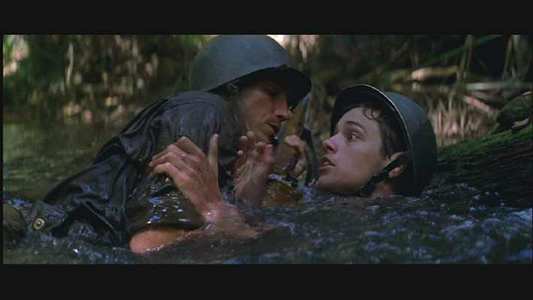Review of Thin Red Line, The
Introduction
It has been argued ad nauseum by impatient critics and audiences that Terrence Malick’s bleak and disturbing adaptation of James Jones’ stirring account of the WWII battleground of Guadacanal, is a film of considerable pretension, incoherence and artistic elitism. Criticisms that are frankly rendered mute by anyone willing to give half an iota of attention to this rich, symbolic account of the destructive nature of warfare. Both a rousing (albeit chilling) battlefield spectacle and a diverse and deeply insightful metaphysical examination of the individual versus camaraderie and collective responsibility; the horror of man’s mechanised violence versus the mysterious beauty of the humbling natural world. Rarely, if ever, has a commercial war picture taken on such a diverse set of thematic elements in such a richly textured and unflinchingly truthful manner.

Video
A resplendent and beautifully photographed picture perfectly suited to the crisp, evocative splendour of a clean and imperfection free digital transfer which brilliantly facilitates the entirely perfect editing by Billy Weber and Leslie Jones.

Audio
A cracking sound mix, in ambience, dialogue and crispness of sound editing during the battle sequences.

Features
Considering Malick’s final cut is about half as long as it once was, a few deleted scenes expanding on the roles of Adrien Brody and John C. Reilly, who are sorely neglected in this cut, would have been appreciated. Alas, we get no such thing. Although it would have been too much to expect a commentary from the notoriously shy auteur Mallick, who has consistently withheld from press and marketing interaction since the mid-seventies, a Making of Feature or Behind the Scenes footage doesn’t seem like too much to ask. What we do get is the excellent theatrical trailer that makes the best use out of Mallick’s startling imagery. We also get a collection of Melanesian Songs that make for a delightfully unconventional addition, although curiously perverse given the extras that are not present. Its just as well the genuine article is so essential.

Conclusion
Rather than being particularly beguiling (as many have argued) ‘The Thin Red Line’ is surprisingly accessible after repeated viewings, basically the closest thing to a cinematic treatise on Emerson’s pantheist notions of the intertwining of God, Man and Nature as one embodied and holistic group (thus making man’s violations of the pure sanctity of Nature as gut-wrenching as the violation of God’s divine and sacred right to decide the fate of Man). Malick’s vivid visual metaphors and striking location footage (photographed by John Toll) are potent and memorable, as is the consistently drawl and poetic voice-over that links the apparently incoherent chapters together via an emotional play on mythological, spiritual and philosophical variations on Paradise Lost. ‘The Thin Red Line’s apparent narrative discontinuity is, in fact, entirely illusory, although plot in the conventional sense is deemed arbitrary, the interlinking of various characters and their experiences is not. Rather than the cold detachment levied by critics on its release, ‘The Thin Red Line’ is in actuality, fertile ground for dramatic tension. Most gripping is the ongoing rivalry between the arrogant, snarling and ambitious Colonel Tall (a superb Nick Nolte) and understated, compassionate and mild-mannered Captain Staros (Elias Koteas). Their verbal cross-fires and intense conflict pits two men at opposing ends in leadership goals and tactics: Staros, a democratic, pragmatic father figure and Tall an authoritarian traditionalist hiding behind a megalomaniacal raging sea of bitterness. Also compelling is the ambiguous dynamic between Sean Penn’s concealed 1st Sergeant Welsh and Jim Caviesel’s vaguely spooky Zen-like surrogate for Malick, Private Witt. Also moving are Ben Chaplin’s tortured, erotic flashbacks to a wife he adores and left behind, a love that haunts his every waking moment.
Occasionally, Malick’s meditation seems more like its ebbing and flowing in and out of consciousness rather than from scene to scene (a jarring, largely ponderous final 15 minutes; one too many emotive longings for Chaplin and rather awkward cameos from George Clooney and John Travolta). Occasionally, Malick’s attempts to weld a exciting, realistic action picture with something more lingering and abstract are somewhat ham-fisted. Ultimately however, ‘The Thin Red Line’ is the perfect antidote to the spectacular filmmaking but unrepentantly nationalistic fervour of Spielberg’s ‘Saving Private Ryan’, a film that uncomfortably set the precedent for Millennial war films. A precedent that ‘The Thin Red Line’ happily demolishes. Flawed, daring and convention-demolishing, this is definitely one of the most ambitious, personal and unforgettable films produced in Hollywood in the last ten years.
Your Opinions and Comments
Be the first to post a comment!